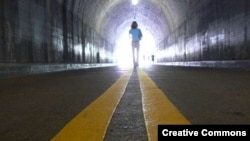Reports of bright lights, feelings of levitation and other near-death experiences reported by those who have been clinically dead and later resuscitated may, after all, be grounded in science.
Researchers at the University of Michigan have shown that shortly after clinical death, the brains of rats display “activity patterns characteristic of conscious perception.”
“This study, performed in animals, is the first dealing with what happens to the neurophysiological state of the dying brain,” said lead study author Jimo Borjigin, associate professor of physiology and neurology at the University of Michigan Medical School.
“It will form the foundation for future human studies investigating mental experiences occurring in the dying brain, including seeing light during cardiac arrest,” Borjigin said.
Twenty percent of cardiac arrest survivors report having had a near-death experience.
“We reasoned that if near-death experience stems from brain activity, neural correlates of consciousness should be identifiable in humans or animals even after the cessation of cerebral blood flow,” said Borjigin.
In the experiments, researchers monitored brain activity in nine anesthetized rats undergoing experimentally induced cardiac arrest. Within 30 seconds, all of the rats showed “a widespread, transient surge of highly synchronized brain activity that had features associated with a highly aroused brain.”
The same patterns were seen in rats undergoing asphyxiation.
“The prediction that we would find some signs of conscious activity in the brain during cardiac arrest was confirmed with the data,” says Borjigin.
Anesthesiologist George Mashour, co-author of the study and assistant professor of anesthesiology and neurosurgery at the University of Michigan, said he was surprised by the high levels of brain activity.
“In fact, at near-death, many known electrical signatures of consciousness exceeded levels found in the waking state, suggesting that the brain is capable of well-organized electrical activity during the early stage of clinical death,” Mashour said.
The study appeared in the journal PNAS.
Researchers at the University of Michigan have shown that shortly after clinical death, the brains of rats display “activity patterns characteristic of conscious perception.”
“This study, performed in animals, is the first dealing with what happens to the neurophysiological state of the dying brain,” said lead study author Jimo Borjigin, associate professor of physiology and neurology at the University of Michigan Medical School.
“It will form the foundation for future human studies investigating mental experiences occurring in the dying brain, including seeing light during cardiac arrest,” Borjigin said.
Twenty percent of cardiac arrest survivors report having had a near-death experience.
“We reasoned that if near-death experience stems from brain activity, neural correlates of consciousness should be identifiable in humans or animals even after the cessation of cerebral blood flow,” said Borjigin.
In the experiments, researchers monitored brain activity in nine anesthetized rats undergoing experimentally induced cardiac arrest. Within 30 seconds, all of the rats showed “a widespread, transient surge of highly synchronized brain activity that had features associated with a highly aroused brain.”
The same patterns were seen in rats undergoing asphyxiation.
“The prediction that we would find some signs of conscious activity in the brain during cardiac arrest was confirmed with the data,” says Borjigin.
Anesthesiologist George Mashour, co-author of the study and assistant professor of anesthesiology and neurosurgery at the University of Michigan, said he was surprised by the high levels of brain activity.
“In fact, at near-death, many known electrical signatures of consciousness exceeded levels found in the waking state, suggesting that the brain is capable of well-organized electrical activity during the early stage of clinical death,” Mashour said.
The study appeared in the journal PNAS.
